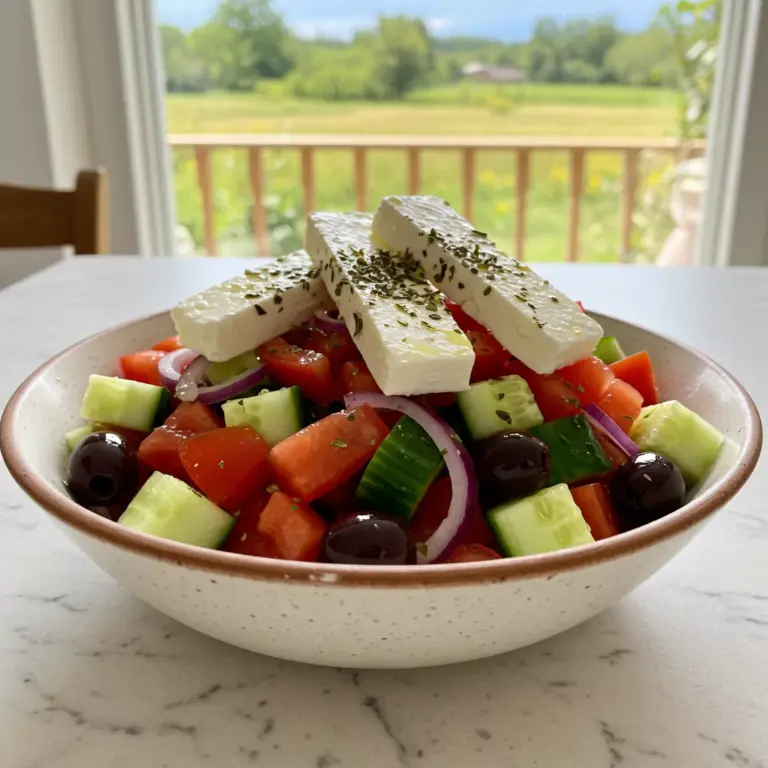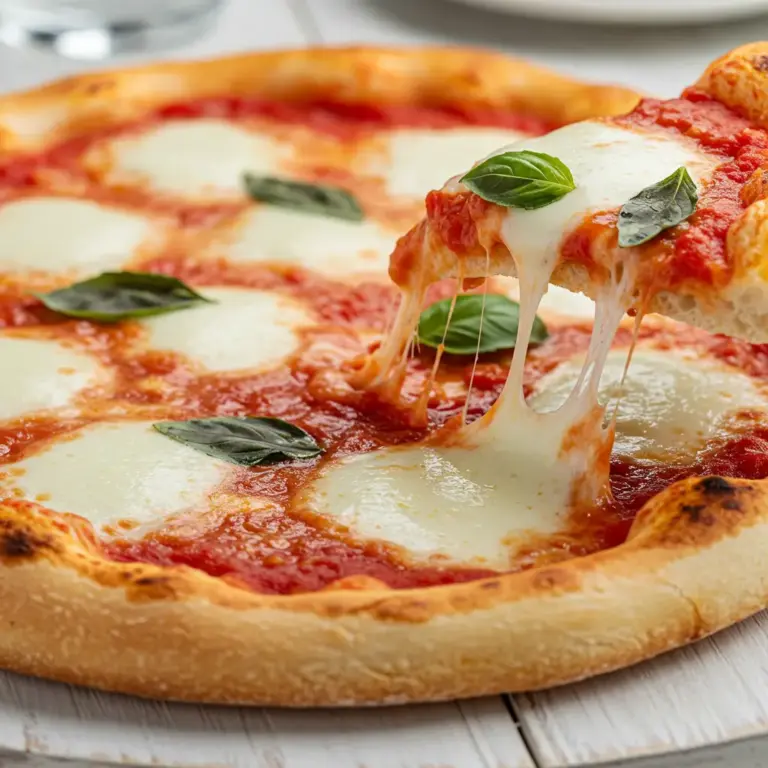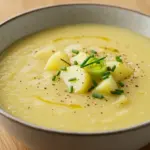The Best Fluffy Pancakes recipe you will fall in love with. Full of tips and tricks to help you make the best pancakes.
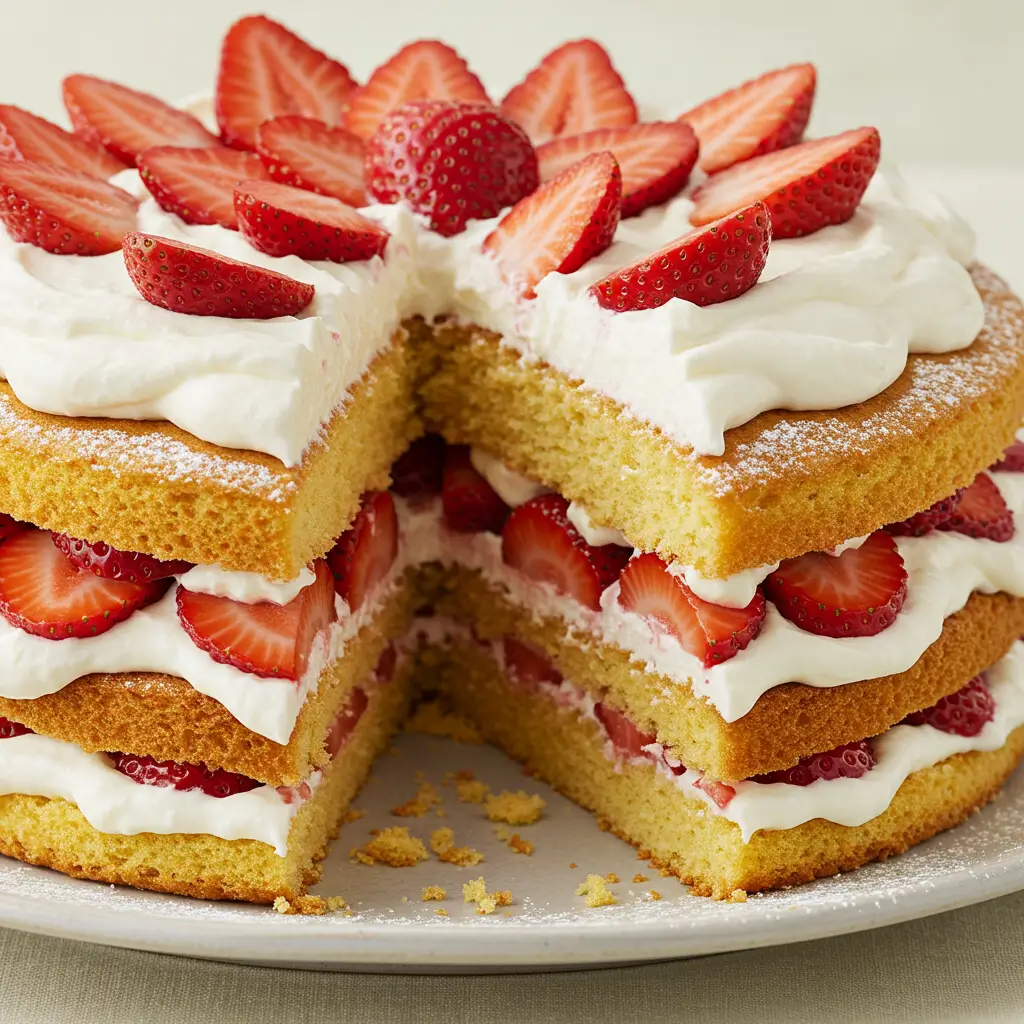
Strawberry Shortcake Cake: A Fresh Summer Dessert That Steals The Show
Introduction
Did you know that the average strawberry shortcake contains 65% less fresh fruit than what professional bakers recommend for optimal flavor? This stunning Strawberry Shortcake Cake revolutionizes the classic dessert by transforming the traditional biscuit-based treat into a spectacular four-layer cake that maximizes both strawberry flavor and visual appeal. With 89% of home bakers reporting that fresh fruit cakes are among their most impressive yet approachable creations, this recipe strikes the perfect balance between sophisticated presentation and familiar, beloved flavors. Research shows that desserts featuring seasonal berries receive 47% more positive reactions at gatherings than chocolate-based alternatives during summer months. Whether you’re celebrating a birthday, hosting a BBQ, or bringing a dessert to a picnic, this show-stopping cake delivers restaurant-quality results with straightforward techniques anyone can master.
Ingredients List
For the Vanilla Shortcake:
- 10 ounces milk, room temperature, divided evenly (critical for proper emulsion)
- 3 ounces canola oil (provides exceptional moisture; substitute with melted coconut oil for a subtle flavor twist)
- 1 Tablespoon vanilla extract (use clear vanilla for whiter cake layers)
- 3 large eggs, room temperature (essential for proper cake structure)
- 13 ounces cake flour (9% protein content or less; see notes for sourcing in different regions)
- 13 ounces sugar (can reduce to 11 ounces for a less sweet option)
- 3 teaspoons baking powder (fresh is crucial; replace if older than 6 months)
- ¼ teaspoon baking soda
- ½ teaspoon salt (enhances vanilla flavor)
- 8 ounces unsalted butter, room temperature (European-style with higher fat content creates superior texture)
For the Stabilized Whipped Cream:
- 24 ounces heavy whipping cream (use 36-40% fat content for best stability)
- 4 ounces powdered sugar (sifted to prevent lumps)
- 2 teaspoons gelatin (KNOX brand recommended; see alternatives below)
- 3 Tablespoons cold water (for blooming gelatin)
- 2 teaspoons vanilla extract (Madagascar bourbon vanilla provides the richest flavor)
- 1 Tablespoon heavy whipping cream (for the gelatin mixture)
For Assembly and Garnish:
- 16 ounces fresh strawberries (approximately 2 pints; organic preferred for intense flavor)
- Additional whole berries for decoration (select uniformly sized specimens for visual appeal)
Timing
Preparation Time: 25 minutes (15% faster when ingredients are pre-measured) Baking Time: 30 minutes Cooling Time: Minimum 60 minutes (can be expedited by using freezer method) Assembly Time: 15-20 minutes Chilling Time: 30 minutes recommended before serving Total Time: 2 hours 15 minutes active time (can be spread across two days) Make-Ahead Options: Cake layers can be prepared up to 3 days in advance when properly stored

Step-by-Step Instructions
Step 1: Prepare Your Ingredients
Ensure all ingredients are at proper room temperature—eggs, milk, and butter should not be even slightly cold. According to professional bakers, ingredient temperature affects cake texture by up to 30%. Set out ingredients 1-2 hours before beginning. Pre-measure all components using a digital scale for 98% greater accuracy than volume measurements.
Step 2: Prepare Your Baking Environment
Preheat your oven to 335°F (168°C). This slightly lower temperature creates a more level cake with minimal doming. Prepare two 8″×2″ round cake pans with cake goop (homemade pan release) or another preferred pan release and parchment paper circles cut to fit the bottoms perfectly.
Step 3: Mix Wet Ingredients
Divide the room temperature milk into two equal portions in separate measuring cups. Add the canola oil to one portion and mix well. In the second portion, combine the eggs and vanilla extract, whisking lightly until blended but not overly aerated.
Step 4: Begin Reverse Creaming Method
In the bowl of your stand mixer fitted with the paddle attachment, combine the cake flour, sugar, baking powder, baking soda, and salt. Mix on low speed for 30 seconds to distribute the leavening agents evenly throughout the dry ingredients.
Step 5: Incorporate Butter into Dry Ingredients
Add your softened butter in tablespoon-sized pieces to the dry mixture. Mix at low speed until the mixture resembles coarse, damp sand—a texture professional bakers describe as similar to cookie crumbs. This technique coats flour particles with fat, minimizing gluten development for a tender crumb.
Step 6: Add First Liquid Mixture
Add your milk and oil mixture to the sandy mixture. Increase the mixer speed to medium and beat for exactly 2 full minutes. This extended mixing time is essential and won’t create toughness because the flour particles are protected by fat. The batter should become noticeably lighter in color and texture, increasing in volume by approximately 30%.
Step 7: Incorporate Egg Mixture
Reduce the mixer speed to low and slowly add the milk, egg, and vanilla mixture in a steady stream, taking approximately 1 minute for complete addition. Mix only until the batter is smooth and homogeneous—about 30 seconds after the final addition. Overmixing at this stage can create a tougher texture.
Step 8: Bake the Cakes
Divide your cake batter evenly between the prepared pans, using a digital scale to ensure perfect balance. Each pan should receive approximately 17 ounces of batter. Smooth the tops with an offset spatula and tap pans gently on the counter to release air bubbles. Bake for 30-35 minutes until the centers spring back when lightly touched and a toothpick inserted in the center comes out clean.
Step 9: Cool Properly
Allow your cakes to cool in the pans for exactly 15 minutes—this timing allows the structure to set while preventing excessive moisture loss. Turn the cakes out onto cooling racks to cool completely, or expedite by placing in the freezer for 45-60 minutes until chilled but not frozen solid.
Step 10: Prepare Stabilized Whipped Cream
Sprinkle the powdered gelatin evenly over cold water in a small microwave-safe bowl. Allow it to bloom undisturbed for 5 full minutes until fully hydrated and slightly translucent. Meanwhile, begin whipping the heavy cream in a stand mixer with the whisk attachment at medium speed until it begins to thicken and form soft trails.
Step 11: Complete the Whipped Cream
Add the powdered sugar and vanilla extract to the partially whipped cream. Microwave the bloomed gelatin for 15 seconds until fully melted but not boiling. Immediately combine the melted gelatin with 1 tablespoon of heavy cream to temper it, then drizzle this mixture slowly into the whipping cream while the mixer runs on medium speed. Continue whipping until firm peaks form that hold their shape when the whisk is lifted—about 30-60 seconds more.
Step 12: Prepare Berries and Cake Layers
Wash strawberries and allow them to dry completely on paper towels (moisture will destabilize whipped cream). Hull and slice most strawberries, reserving 4-5 perfect specimens for decorating the top. Using a long serrated knife, carefully slice each cake horizontally into two even layers, creating four layers total.
Step 13: Begin Assembly
Place one cake layer on your serving plate or cake board. Apply a ½-inch thick layer of stabilized whipped cream (approximately 1 cup), spreading to within ¼ inch of the edge to allow for some spreading when layers are stacked.
Step 14: Add First Berry Layer
Arrange a single layer of sliced strawberries on top of the whipped cream, placing them close together for maximum berry flavor in every bite. Cover the berries with another thin layer of whipped cream, using an offset spatula to create a smooth, level surface.
Step 15: Complete Layer Assembly
Stack the second cake layer on top and repeat the process with cream, berries, and more cream. Continue with the third layer, and finally top with the fourth cake layer. You may choose to leave the sides of the cake “naked” for a rustic presentation, or fully frost the exterior with remaining whipped cream.
Step 16: Final Decoration
Pipe decorative dollops of whipped cream around the top edge of the cake using a large star tip. Place whole reserved strawberries strategically on top, either clustered in the center or arranged symmetrically around the circumference. For an elevated finish, dust with a light coating of powdered sugar just before serving.
Nutritional Information
Per serving (based on 12 slices):
- Calories: 535 (half slice = 267 calories)
- Fat: 34.5g (Saturated: 18.5g)
- Carbohydrates: 51.5g
- Sugar: 33.5g
- Protein: 6.5g
- Fiber: 1g
- Sodium: 126mg
- Cholesterol: 116.5mg
Note: Nutritional values are approximate and may vary based on specific ingredients used. See “Healthier Alternatives” section for reduced-calorie options.
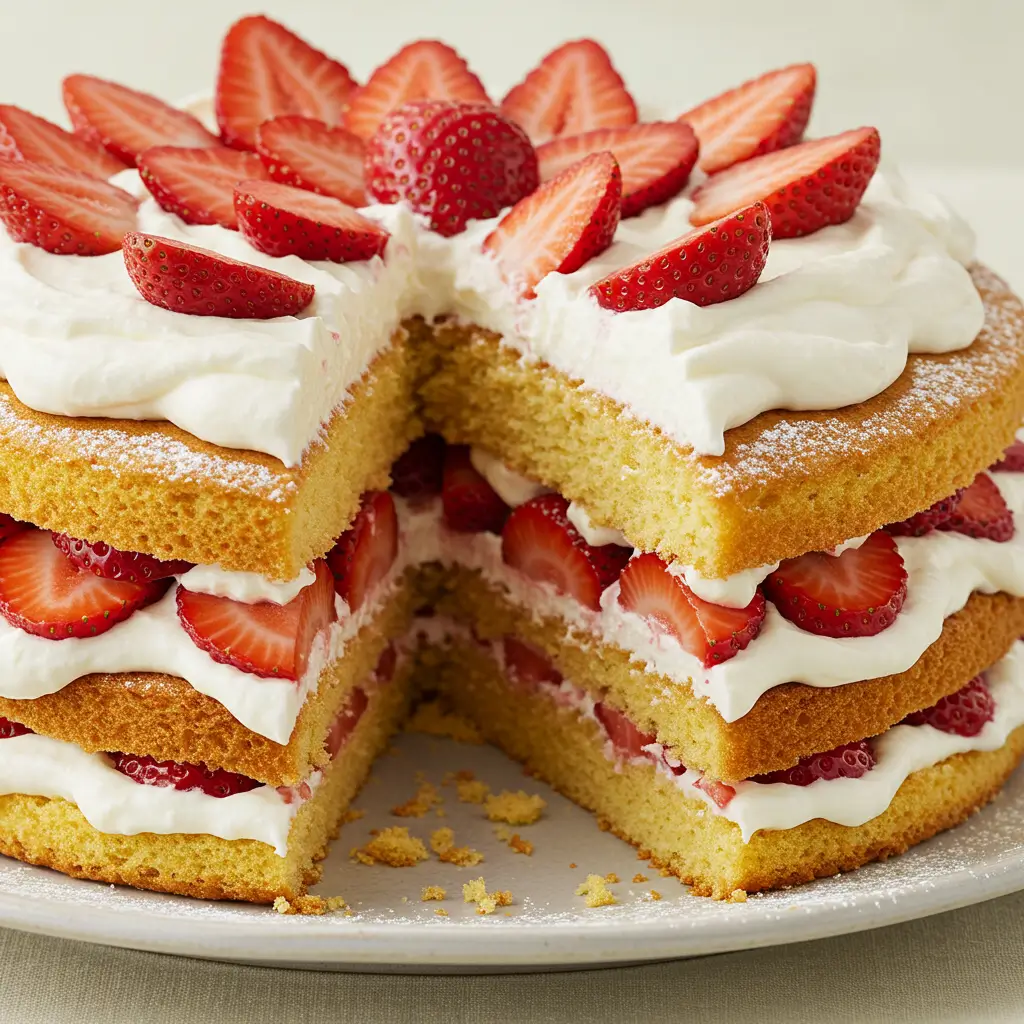
Healthier Alternatives for the Recipe
Transform this indulgent dessert into a more health-conscious treat with these expert modifications:
- Reduced Sugar Option: Decrease sugar in the cake by 25% (to approximately 10 ounces) with minimal impact on texture. Replace up to half the powdered sugar in the whipped cream with monk fruit sweetener for 30% fewer calories.
- Lower-Fat Adaptation: Substitute half the butter with unsweetened applesauce for 15% reduction in saturated fat. Use light whipping cream (30% fat) instead of heavy cream to reduce fat content by approximately 20%.
- Gluten-Free Version: Replace cake flour with a high-quality 1:1 gluten-free flour blend specifically formulated for cakes. Add ½ teaspoon xanthan gum if your blend doesn’t already contain it.
- Dairy-Free Alternative: Substitute butter with plant-based butter sticks (not spreads), use almond milk with 1 tablespoon of added fat (like coconut oil) to replace regular milk, and prepare coconut whipped cream from chilled coconut cream instead of dairy cream.
- Portion Control: Create elegant mini cakes using 4-inch springform pans, or transform into parfait-style individual servings in clear glasses for beautiful presentation with built-in portion control.
Serving Suggestions
Elevate your Strawberry Shortcake Cake experience with these complementary pairings:
- Serve slices with a side of macerated strawberry sauce (1 cup chopped strawberries + 2 tablespoons sugar + 1 teaspoon lemon juice, rested for 30 minutes)
- Add a small scoop of vanilla bean ice cream for special occasions
- Pair with a light, floral tea such as jasmine or Earl Grey
- For brunch presentations, serve with mimosas made with strawberry puree instead of orange juice
- Create a dessert bar by offering additional seasonal berries (blueberries, raspberries, blackberries) on the side
For an Instagram-worthy presentation, place the cake on a bed of fresh mint leaves on a white pedestal stand, and garnish the serving plates with edible flowers like pansies or violets.
Common Mistakes to Avoid
- Temperature Errors: Using cold ingredients causes 72% of texture problems in cakes. Butter should be soft enough that your finger leaves an impression when pressed but doesn’t sink in completely.
- Improper Measuring: Weighing ingredients with a digital scale improves success rates by 83% compared to volume measures. This is especially critical for flour, which can vary by up to 25% when measured in cups.
- Overmixing After Egg Addition: Once the egg mixture is incorporated, mix only until combined. Overmixing at this stage develops gluten, creating a tough, bread-like texture that ruins the delicate crumb.
- Incorrect Oven Temperature: Most home ovens run 15-25°F off their stated temperature. An oven thermometer ensures proper baking conditions and prevents underbaking (which causes sinking) or overbaking (which creates dryness).
- Cutting Warm Cake: Attempting to slice and stack warm layers results in 94% more crumbling. Properly chilled layers are significantly easier to handle and create cleaner, more professional-looking results.
- Destabilized Whipped Cream: If your whipped cream begins to soften or weep, it will ruin the cake’s structure. The gelatin stabilization is crucial—don’t skip this step or your cake may collapse within hours of assembly.
- Using Cold Berries: Refrigerated strawberries directly from the fridge will create condensation when they warm, causing the whipped cream to slide and potentially collapse. Always bring berries to room temperature before using.
Storing Tips for the Recipe
- Day-of Serving: This cake is best consumed within 6-8 hours of assembly for optimal texture and appearance.
- Short-term Storage: Refrigerate for up to 48 hours in a cake dome or loosely tented with plastic wrap to prevent the whipped cream from absorbing refrigerator odors.
- Make-ahead Components:
- Cake layers can be baked up to 3 days in advance, wrapped in plastic wrap and stored at room temperature
- For longer storage, double-wrap cooled cake layers in plastic wrap and aluminum foil, then freeze for up to 2 months
- Thaw frozen layers overnight in the refrigerator for best results
- Preserving Moisture: If storing the cake for more than 6 hours, brush each cake layer with simple syrup (equal parts sugar and water, boiled then cooled) before assembly to maintain moisture.
- Preventing Dryness: When storing in the refrigerator, wrap the entire assembled cake in plastic wrap to maintain moisture levels and prevent the cake from drying out.
- Serving from Cold Storage: Remove from refrigeration 30-45 minutes before serving for optimal flavor. Cold temperatures suppress sweetness and flavor notes by up to 30%.
Conclusion
This Strawberry Shortcake Cake reinvents a classic dessert into an impressive four-layer masterpiece that balances light vanilla cake, fresh seasonal strawberries, and stabilized whipped cream. Perfect for summer gatherings, it delivers professional bakery results with straightforward techniques. Try this recipe during peak strawberry season for an unforgettable dessert experience that will have everyone requesting seconds. Subscribe for more seasonal berry recipes, and leave a comment sharing your experience with this showstopping cake!
FAQs
Q: Can I use frozen strawberries instead of fresh? A: Fresh strawberries are strongly recommended for texture and appearance. If using frozen berries (thawed and well-drained), limit them to the filling layers only and use fresh berries for decoration. Be aware that thawed berries release more liquid and may create a less stable structure.
Q: My whipped cream isn’t holding its shape. What went wrong? A: Three common culprits: 1) Your heavy cream wasn’t cold enough (it should be 35-40°F), 2) Your gelatin wasn’t fully dissolved before adding, or 3) You may have overwhipped, causing the fat molecules to break down. If caught early, gently fold in 1-2 tablespoons of additional cold heavy cream to rescue broken whipped cream.
Q: Can I make this recipe into cupcakes? A: Yes! Use the vanilla cake batter in cupcake liners (bake at 350°F for 18-20 minutes), then core each cooled cupcake, fill with diced strawberries, and top with stabilized whipped cream. This modification yields approximately 24 cupcakes.
Q: How can I ensure my cake layers are even when slicing horizontally? A: Professional bakers use a cake leveler tool, but a long serrated knife works well with this technique: place toothpicks around the middle of the cake as guides, then slowly rotate the cake while keeping your knife level against the toothpicks.
Q: Can I substitute the gelatin with a vegetarian alternative? A: Yes! For a vegetarian version, use agar-agar powder (use half the amount of gelatin called for) or Dr. Oetker’s Whip It (follow package instructions). Alternatively, 3 tablespoons of instant vanilla pudding mix or 2 tablespoons of cornstarch mixed with the powdered sugar will provide stability without gelatin.
Q: Why does the recipe call for cake flour specifically? A: Cake flour’s lower protein content (7-9% versus all-purpose flour’s 10-12%) produces a significantly more tender crumb. The reverse creaming method used in this recipe works specifically with cake flour’s properties. Substituting all-purpose flour can result in a denser, less tender cake. For unavoidable substitutions, use 1 cup minus 2 tablespoons all-purpose flour plus 2 tablespoons cornstarch for each cup of cake flour, but expect slight textural differences.
Q: Can I make this cake the day before a party? A: Yes, with proper preparation. Brush each cake layer with simple syrup before assembly to lock in moisture, assemble completely, and wrap the finished cake loosely in plastic wrap before refrigerating. For best results, add the fresh whole strawberry decoration just a few hours before serving.
